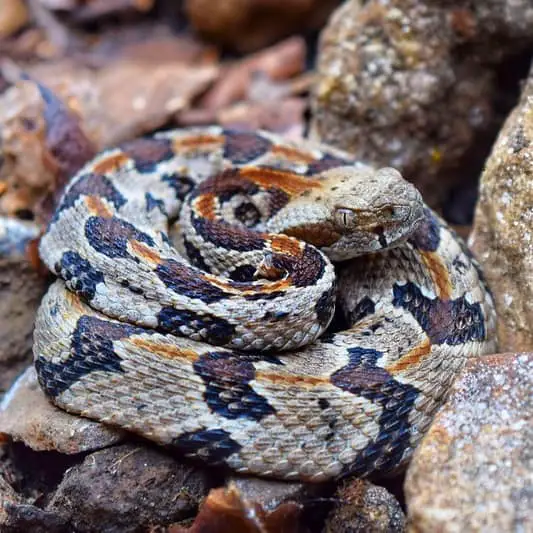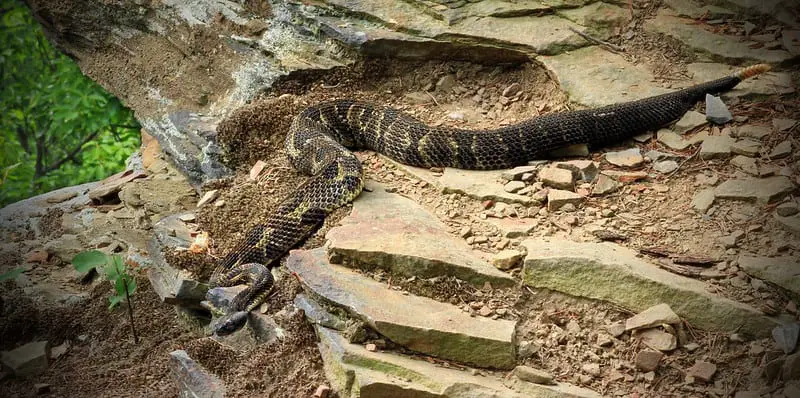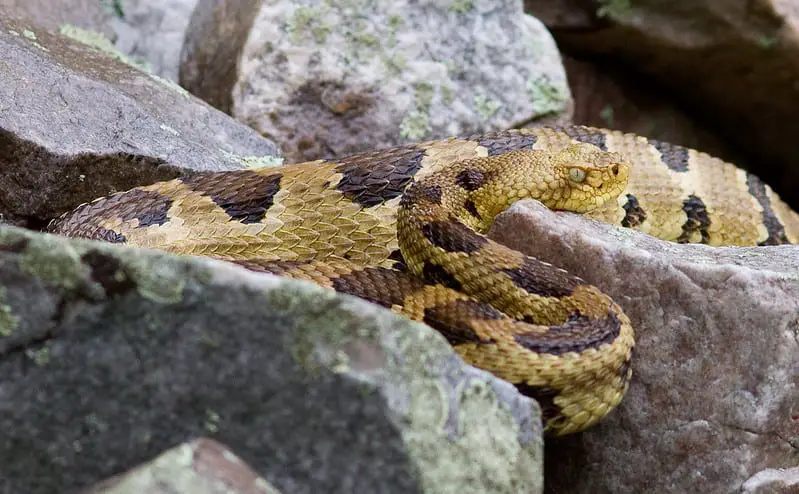The timber rattlesnake, Crotalus horridus, is a venomous snake native to the Eastern part of North America. It is usually around 40 inches (100 cm) long and light or dark brown with several dark brown, jagged, crossband patterns around its body. Even though bites rarely occur, an untreated timber rattlesnake bite may be fatal.
Description
The main body colors of the timber rattlesnakes are various grey and brown tones, sometimes even orange. While coloration and patterns can vary greatly between different specimen, there are two main morphs of the timber rattlesnake:
The light morph has light brown tones as their main body color with dark brown, jagged crossbands. This morph often also has an orange line along its back.

The base color of the dark morph appears dark brown, sometimes grey or even black (especially towards the tail). They have several dark brown or grey crossbands around their body that are surrounded by lighter colors.

At the end of their tail, timber rattlesnakes have, as all other rattlesnake species as well, a rattle.
Size
An adult timber rattlesnake reaches a length between 35-60 inches (90-150 cm). Most adults are around 40 inches (100 cm) long and weigh between 1.5-3 lbs (750-1500 g). The largest ever recorded timber rattlesnake was 74.5 inches (189 cm) long and weighed nearly 10 lb (4.5 kg).
Hunting Behavior
The main prey for timber rattlesnakes are small mammals like squirrels, rats and mice. Occasionally, they also feed on birds or other snakes (especially garter snakes). They often wait on fallen logs or elevated rocks for clueless prey that passes by. As soon as their prey is in range, they shoot their head towards it and inject a lethal dose of venom into its system. After the bite, the snake follows the struck prey until it is immobilized by the venom and ingests it as a whole.

Bite
The venom of the timber rattlesnake snake is very similar as that of the eastern diamondback rattlesnake but it is considered to be somewhat less effective. It leads mainly to local tissue destruction and pain, followed by general nausea. Untreated, the bite of a timber rattlesnake can be fatal, although reports of this are very rare. The composition of the venom and its potency varies with the geographic range of the snake.
The timber rattlesnake is considered less aggressive than some of its close relatives. Before attacking and biting, it generally threatens its opponent with intense rattling of its rattle. If you encounter a timber rattlesnake (or any other venomous snake) in the wild, stay calm. Don’t make any sudden movements ald slowly retreat backwards away from the snake. Remember: the snake is afraid of you and is trying to defend itself. So don’t give off the impression of being a threat to it.
If you are bitten, head to the nearest hostpital or medical station as soon as possible.
Habitat
The vertical distribution of timber rattlesnakes ranges from 1,000 to 4,000 feet (300-1,200 m), depending on the area. The animals live in forests with pines and oak trees, with dense undergrowth of ferns, ivy and blueberries. In Northern America they are often seen in hemlock fir forests.
Males and non-pregnant females prefer a habitat that is weel-covered with shade during the summer months. Pregnant females prefer lighter forests with little undergrowth.
The long hibernation that can range from October until May takes place in a den. Mostly under rocks in deep caves, on slopes with south-east orientation together with other forest rattlesnakes, vipers and copperheads.
Timber rattlesnake range in the USA
The range of the timber rattlesnake stretches over a large part of the eastern and southeastern United States of America from the Great Lakes in the north to northern Florida (it does not occur on the peninsula itself) and southern Texas. The timber rattlesnake can be found in these states: Minnesota, Iowa, Eastern Nebraska, Kansas, Oklahoma, Eastern Texas, Missouri, Arkansas, Louisiana, Wisconsin, Illinois, Indiana, Ohio, Kentucky, Tennessee, Mississippi, Alabama, Georgia, Florida, South Carolina, North Carolina, Virginia, West Virginia, Pennsylvania, Delaware, Maryland, New Jersey, New York, Connecticut, Massachusetts, Vermont and New Hampshire.
Scientific classification of Crotalus horridus
- Kingdom: Animalia
- Phylum: Chordata
- Class: Reptilia
- Order: Squamata
- Suborder: Serpentes
- Family: Viperidae
- Genus: Crotalus
- Species: Crotalus horridus